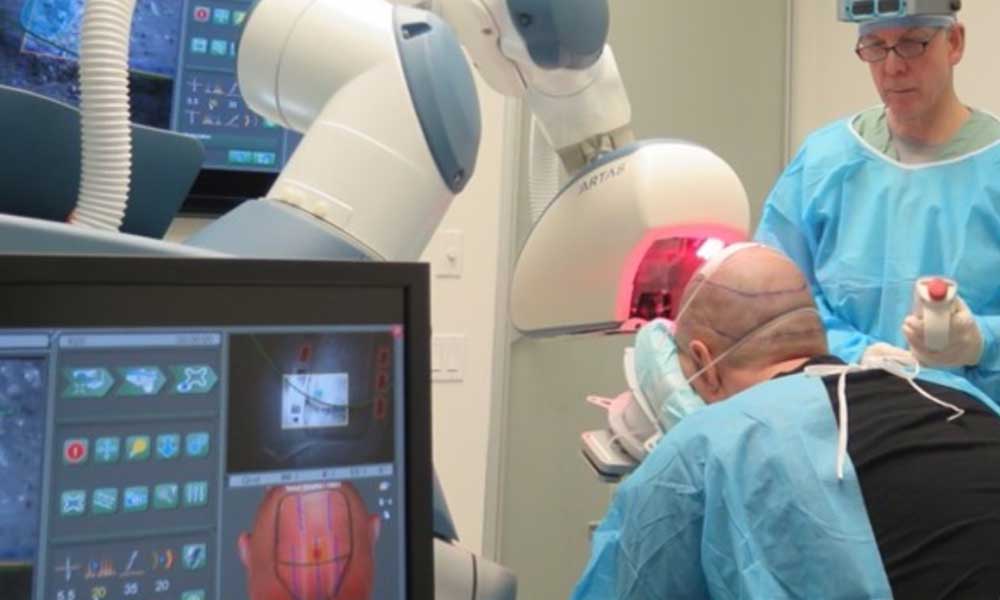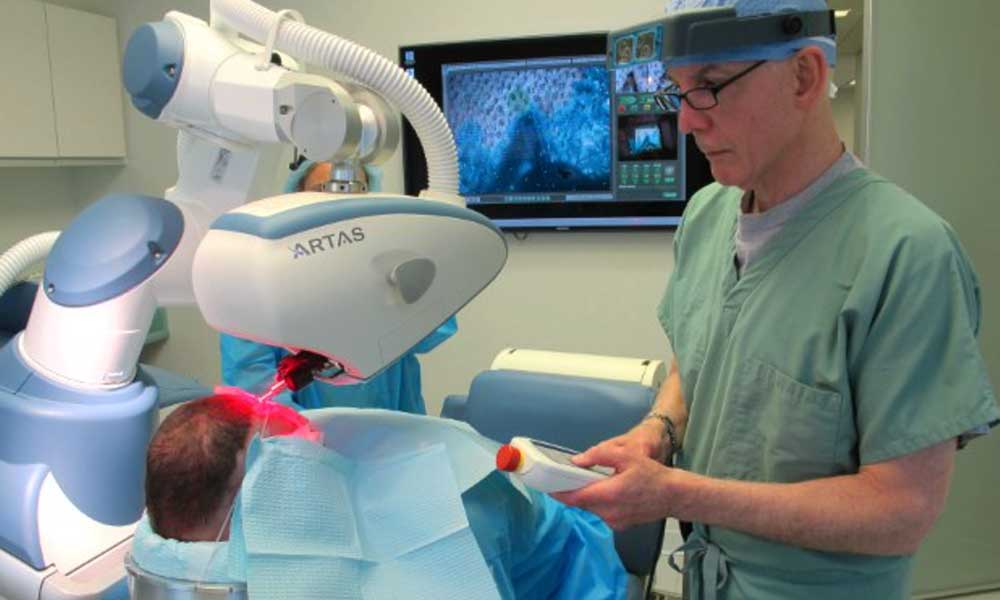Introduction
Robotic Hair Transplantation is revolutionizing the hair transplant industry.
Since its introduction in 2014, Robotic Hair Transplantation (RHT) has quickly grown in popularity and is now the preferred method of hair transplantation for many people. It eliminates many of the problems associated with traditional hair transplantation, such as high costs, long recovery times and scarring.
Robotic Hair Transplantation is a minimally invasive procedure that uses advanced robotics to precisely extract individual follicular units (FU) from a donor area. The FU’s are then transplanted into recipient sites where they will grow into natural-looking and permanent results. This technique provides superior results over traditional methods and has shorter recovery times, making it a popular choice for many people seeking to restore their hairline or thicken thinning areas.
This article explores the benefits and limitations of Robotic Hair Transplantation, as well as some key tips to ensure a successful outcome.
Introduction to Robotic Hair Transplantation
Robotic hair transplantation is revolutionizing the industry of hair restoration. It’s an advanced robotics device, called the ARTAS Robotic Hair Transplant, which is designed to automate and improve the process of hair restoration surgeries. This device utilizes Artificial Intelligence (AI) technology to map out the donor area for follicular unit graft extraction, as well as accurately locate and select recipient sites for precise placement of extracted follicles on the scalp.
The ARTAS system derives its name from Automated Robotic Technology & Advanced System and it is designed to bridge both worlds of robotics and hair restoration. It is a computer-assisted robotic system that offers a minimally invasive option for performing hair transplants compared to manual procedures. It is also enabling more hair transplants than ever before by robots. The ARTAS system helps reduce treatment time, provide consistent results, eliminate human error and offer shorter recovery times compared to traditional surgical techniques.

Benefits of Robotic Hair Transplantation
Robotic hair transplantation, a revolutionary new procedure, is quickly becoming the go-to for those looking for lasting solutions to hair loss. Its advantages over traditional Follicular Unit Transplantation (FUT) methods include a graft survival rate of up to 98%, no linear scarring, and faster procedures with less recovery time.
Robotic hair transplants are performed using the ARTAS robotic system, an FDA-approved device that uses computer imaging and surgical robotics technology for precise and consistent results. During the procedure, the robot scans and selects individual follicles from the donor area before creating thousands of recipient sites in the balding region. This process results in natural-looking hair growth without any linear scarring or significant downtime.
Furthermore, robotic hair transplants produce impressive results with little risk of complications like infection or pain during recovery. This makes them ideal for those who want a safe and effective solution to their hair loss without requiring extensive recovery time.
Understanding the Robotic Hair Transplant Procedure
The ARTAS Robotic Hair Transplant Procedure is a minimally invasive, physician-assisted approach to restoring natural-looking hair. While it may differ somewhat from patient to patient, the exact procedure typically follows the same basic steps:
- The area of scalp to be transplanted is properly numbed with local anesthesia for a comfortable experience.
- The ARTAS robot precisely identifies and harvests healthy donor follicles.
- Next, the robot creates recipient sites in the balding area of the scalp and prepares follicles for implanting.
- Finally, follicles are implanted at specific depths and angles using a special implantation tool in order to replicate natural hair growth patterns as closely as possible.
The entire process usually takes 5-7 hours and results in a full head of natural-looking hair immediately following surgery without any visible scarring or discomfort. Because it is physician-assisted, it is also cleared by the FDA making it a safe and reliable choice for those looking for an alternative to traditional methods of hair transplantation.
Cost of Robotic Hair Transplantation
Robotic hair transplantation is quickly revolutionizing the world of hair transplantation with its ability to deliver a more precise and natural-looking outcome in both cost and time.
Robotic Hair Transplantation technology utilizes an automated system to conduct the follicular unit extraction (FUE) process with unsurpassed accuracy. This level of precision is a major factor in reducing the cost of the procedure.
The cost savings can be attributed to several factors:
- Reduced number of grafts: The greater precision of the robotic system reduces the number of hairs needed for grafts, resulting in a lower cost for each recipient area.
- Reduced downtime: The robotic system does not require as much downtime as manual FUE, which can reduce recovery costs.
- Reduced labor costs: Robotic Hair Transplantation does not require as many skilled laborers to perform the procedure, which reduces labor costs associated with hair transplants.
This combination of factors makes robotic hair transplants an attractive option for those looking for a high-quality, less costly hair transplant option.

The Best Candidates for Robotic Hair Transplantation
Robotic Hair Transplantation, a revolutionary treatment that is quickly becoming the gold standard in hair transplantation, is an ideal option for many people looking to restore areas of baldness. This advanced technology offers patients an accurate, minimally invasive and safe solution to their hair loss problems.
The best candidates for this procedure are people seeking to restore areas of baldness, thinning, and/or a receding frontal hairline. Men and women who want to remedy their pattern baldness are also good candidates, but it is important to note that patients need to be 25 years of age or older before beginning treatment. Additionally, the ideal candidate should have enough hair in other areas of his or her scalp for donor grafts.
Robotic Hair Transplantation is a valuable option for individuals who are looking for a minimally invasive and highly successful way to restore lost or thinning hair. With this advanced technology, patients can achieve natural-looking results without scarring or downtime.
Post-Transplant Care With Robotics Hair Transplant
Robotic Hair Transplantation (RHT) offers not just a revolutionary hair transplantation procedure, but an approach to post-transplant care as well. After RHT, patients generally only experience mild discomfort for up to 48 hours, and any signs of the procedure will nearly vanish within a week.
Post-procedure care involves following the advice of professional healthcare workers and taking any medications that may be prescribed. Additionally, a few simple steps can ensure that the transplant area heals successfully in order to enjoy natural hair growth results:
- Avoid heavy physical activity for two weeks after the procedure
- Refrain from strenuous activities such as swimming or sauna use for two weeks after the procedure
- Keep the scalp dry until completely healed and avoid using shampoo products with harsh chemicals
- Avoid exposing the scalp to direct sunlight or other heat sources
- Eat healthy foods with plenty of protein and vitamins
- Avoid smoking and consuming alcohol
- Avoid rubbing or scratching around the transplanted area
By taking these steps and following doctors’ instructions, new hairs should begin to grow approximately three months after RHT is performed – transforming even thinning, difficult to treat areas into lush healthy ones with long-term results delivered in a fraction of time compared to traditional hair transplants, revolutionizing the industry all over again!
Conclusion
Robotic Hair Transplantation has revolutionized the hair transplant industry, offering a cost-effective, safe, and minimally invasive solution to hair loss. Its unique features, including automated harvesting and implantation of follicular units, precise and accurate implantation, less manual labor, and improved graft survival rate, make robotic hair transplants a superior solution compared to the manual approach. The procedure is coupled with faster recovery time, minimal scarring, and a higher success rate, thus it is no wonder that robotics hair transplants are becoming increasingly popular with hair transplant patients and practitioners alike.































